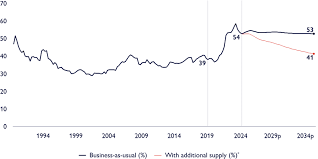Canada’s housing inventory has returned to its long-term average, signaling a stabilizing real estate market. Recent data shows that the number of homes available for sale aligns with historical norms, offering both buyers and sellers more balanced conditions.
Real estate experts say the improvement in inventory provides relief for buyers who faced tight markets in recent years. Limited supply previously drove up prices and created competition for homes, particularly in major urban centers. The return to average levels may help moderate price growth and ease affordability pressures.
The report indicates that the total number of active listings is now comparable to the historical mean, suggesting that the market is moving toward equilibrium. This development reflects a combination of new home construction, slower sales activity, and cautious market behavior among homeowners.
While the overall inventory aligns with long-term trends, regional differences persist. Some cities continue to experience lower-than-average supply, particularly in high-demand neighborhoods, while other areas have a surplus of homes. Analysts suggest that local factors such as population growth, new development, and migration patterns influence these variations.
Housing experts note that a balanced inventory benefits both buyers and sellers. For buyers, more options reduce competition and provide greater choice. For sellers, a market closer to historical averages can support fair pricing without the extreme fluctuations seen in tight or oversupplied markets.
Recent months have seen a slowdown in home price growth in several Canadian regions. Analysts attribute this trend to higher mortgage rates, which have tempered buyer demand. However, the stable inventory provides a buffer against sudden market shocks and helps maintain steady conditions.
Builders and developers continue to play a key role in stabilizing inventory levels. Ongoing construction projects, including single-family homes and multi-unit developments, are gradually adding to the available housing stock. Despite challenges such as rising material costs and labor shortages, new construction is helping align supply with demand.
The federal and provincial governments are also monitoring housing trends closely. Policies aimed at improving housing supply, supporting first-time buyers, and ensuring affordability are essential to sustaining a balanced market. Experts suggest that coordinated efforts between governments and developers are needed to maintain inventory levels at healthy levels over the long term.
In addition to supply, buyer behavior is influencing inventory trends. Some potential homeowners are waiting for interest rates to stabilize or for more favorable economic conditions before entering the market. This cautious approach has contributed to a more balanced inventory as fewer properties are rapidly absorbed by buyers.
Financial analysts highlight that a stable housing inventory can also reduce volatility in the mortgage and real estate sectors. Predictable supply and demand conditions support steady home prices, which in turn helps maintain confidence among lenders, investors, and homeowners.
Overall, Canada’s housing market is showing signs of stability as inventory levels match long-term averages. While challenges remain in certain high-demand areas, the general trend suggests a healthier balance between supply and demand. Buyers can expect more options, while sellers may see fairer pricing for their homes.
As the market continues to evolve, monitoring inventory trends remains crucial. Stable housing levels are essential for affordability, economic growth, and the overall health of Canada’s real estate sector. Experts recommend that buyers, sellers, and policymakers keep track of local and national inventory trends to make informed decisions in the coming months.


